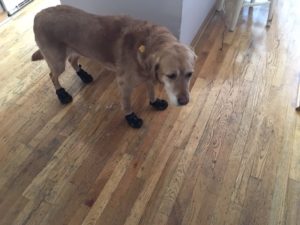My 5 Tips for Walking Your Dog in Winter Weather Conditions
by Beth

Whitney in her snow booties
Our Chicago apartment is surrounded by other big buildings. Most ground floor units are retail, and shop owners don’t like their customers falling on ice. So they shovel their sidewalks. Trouble is, they put salt on their sidewalks, too. LOTS of salt.
The American Dog Trainers Network website warns that ice-melting chemicals and salt on sidewalks and roads can cause severe burning to a dog’s footpads. “Whenever possible,” says the web site, “avoid walking your dog through these substances…”
Trust me, I’d avoid walking Whitney through those “substances” if I could. But for one, I can’t see the dang stuff. And two, if we avoided the salt, we’d never get anywhere. We’d be trapped, just like my friends who use wheelchairs and walkers and can’t make it over the piles of snow in the crosswalks.
Musher’s Secret to the rescue! Musher’s Secret is this waxy stuff you can get online from pet suppliers. It smells a bit like Vicks Vaporub, and all you need to do is rub this goop on your dog’s paws before you leave home – I recommend you do this near the door outside so the wax doesn’t get all over your indoor carpet! When temperatures are this low, the wax hardens on Whitney’s paws the second we get outside and the salt can’t get through to her pads. Whitney is not fond of having her paws rubbed, so I alternate between using Musher’s Secret and putting dog booties on her. Some other Polar Vortex tips for those of you with service dogs:
- Keep your trips outside as short as possible.
- Be aware that even though dogs have fur coats, they are just as susceptible to hypothermia and frostbite as we are. Dogs should not be outside in temperatures below zero for more than a few minutes.
- Protect your dog’s paws even when there is no salt on the ground. Pavement feels awfully cold when the temperature is below zero, and paws should not make contact with the cold pavement without some sort of barrier to protect them.
- Dog sweaters and coats can provide warmth for short-haired dogs – they don’t have the double coat that protects dogs like huskies or Bernese mountain dogs from extreme temperatures.
- Dogs with health sensitivities, such as heart or lung issues, are at a much greater risk in temperatures below zero. Air is bitter cold and very difficult to breathe in, so monitor your dogs very carefully, even after their walk is complete and they are inside.
I’ve been working with guide dogs nearly 30 years now and we’ve made it through a lot of cold winters. My advice: be careful, take your time, and remember to reward your dogs with a lot of affection and play when you get back inside — they deserve it!.






